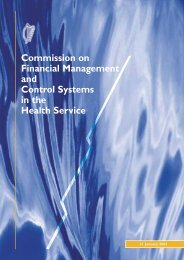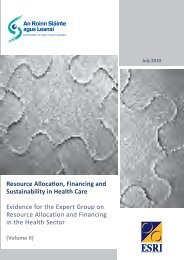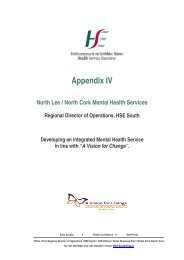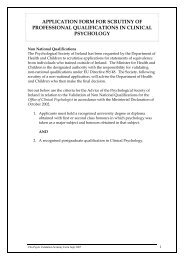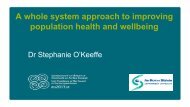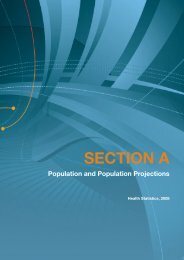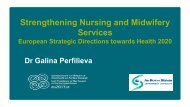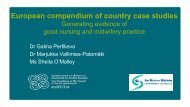All Ireland Traveller Health Study Our Geels - Department of Health ...
All Ireland Traveller Health Study Our Geels - Department of Health ...
All Ireland Traveller Health Study Our Geels - Department of Health ...
Create successful ePaper yourself
Turn your PDF publications into a flip-book with our unique Google optimized e-Paper software.
<strong>All</strong> <strong>Ireland</strong> <strong>Traveller</strong> <strong>Health</strong> <strong>Study</strong><br />
The NLSC/GUI study has contributed some <strong>of</strong> the most recent data on child health indicators for<br />
comparison with AITHS. NLSC/GUI is a large, prospective cohort study which to date has gathered<br />
baseline data on two subgroups: 9-month old infants and 9-year-old children. For this study, the<br />
data relating to the 9-year-old (n=8,570) were compared with the 9-year-old in AITHS, with specific<br />
comparisons being made with the NLSC/GUI children in SC 5-6, or to those in the lowest quintile <strong>of</strong><br />
family income. Data were collected both from the parents, and from the children themselves (in the<br />
case <strong>of</strong> the 9-year-old). Where relevant in this paper, it is clarified whether the data were by child or<br />
parent-report. Data tables have kindly been provided by Pr<strong>of</strong>essor James Williams <strong>of</strong> the Economic and<br />
Social Research Institute (ESRI), and other data has been gathered from the NLSC main report (Williams<br />
et al., 2009).<br />
The Continuous Household Survey is a yearly survey carried out by the Northern <strong>Ireland</strong> Statistics and<br />
Research Agency (NISRA). It samples 1% <strong>of</strong> the NI households, and gathers information on a number<br />
<strong>of</strong> household factors: population, housing, employment, health and education. Data is available by<br />
household income and by employment skill set <strong>of</strong> the household. In this document, where specific<br />
comparisons are made between the NI data and the AITHS data, the default comparison is between the<br />
AITHS data and the general Continuous Household Survey data. In cases where the comparisons are<br />
made with the NI data relating to semi skilled or unskilled workers only (comparable with the CSO SC<br />
5-6 grouping), this is specified.<br />
Analysis Strategy<br />
<strong>All</strong> publications <strong>of</strong> the most significant recent population surveys (Kelleher et al., 2003; Morgan et al.,<br />
2007; Williams et al., 2009; O’Mahony et al., 2007; INSIGHT ’07 (2008), Nic Gabhann et al., 2007; Kelly et<br />
al., 2009; Krieger et al., 2005) were accessed and data were abstracted. To access data specific to either<br />
the medical card holders or the SC 5-6 groups <strong>of</strong> the general population, raw data was also required<br />
from a number <strong>of</strong> studies. Raw data files were accessed for the Lifeways study, INSIGHT ‘07 and the<br />
SLAN 2002 and 2007 studies. In the case <strong>of</strong> the latter 3 studies, the data was received through the<br />
ISSDA. Investigators from the HBSC, NLSC/GUI and SLAN 2007 studies kindly made either raw data<br />
or study-specific tables available for comparison, and we acknowledge their assistance. Further data<br />
relating to the general population in Northern <strong>Ireland</strong> were obtained from both the NI Continuous<br />
Household Survey (2008-2009) and the 2005 Infant Feeding Survey (Bolling et al., 2007). We specifically<br />
refer to the work <strong>of</strong> Pr<strong>of</strong>essor Nancy Krieger in Harvard School <strong>of</strong> Public <strong>Health</strong> in Boston because she<br />
is a world authority on the relative contribution <strong>of</strong> race, ethnicity and minority community affiliation to<br />
health, an under–researched but relevant topic for <strong>Traveller</strong> health. Frequencies are presented as valid<br />
percentages in all cases. <strong>All</strong> data are presented as descriptive statistics. Where possible, tabulations<br />
were performed by sex and by age group, in keeping with the presentation <strong>of</strong> the AITHS data. Because<br />
<strong>of</strong> the sample size and the large number <strong>of</strong> variables for consideration, no formal statistical testing <strong>of</strong><br />
hypotheses was undertaken as part <strong>of</strong> this comparative description.<br />
66



